How The Callisto Protocol evolved when it became "too much like Dead Space"
"Times have changed since Dead Space," but The Callisto Protocol remembers its best ideas
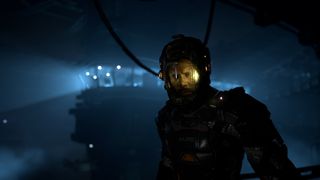
It's hard to talk about The Callisto Protocol without talking about Dead Space. That's especially true after the release of the first Callisto Protocol gameplay trailer, which practically screams spiritual successor. I'm reminded of this as I prepare to sit down with Striking Distance studio head Glen Schofield – who, once upon a time, served as executive producer of the original Dead Space at EA. As we sit down in a sweltering outdoor booth at Summer Game Fest's Play Days in Los Angeles, I tell Schofield that I keep comparing things to Dead Space in my head. He's quick to acknowledge that, "yeah, everybody does."
"Times have changed since Dead Space," he tells me. "The player has changed, the fan has changed. You kind of feel what the mood is out there. There's a little changing here and there that you have to do. Horror has changed. We had to adapt and adjust, and that's always fun, trying to figure out what are the new trends."
A mind of its own
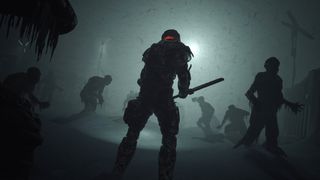
"I knew going into this there were gonna be comparisons," he continues. "It was up to us on the game team to make it its own thing. In the beginning, I was like, 'Nothing like Dead Space!' And then as we're going through development, it's my DNA, I can't help it sometimes. And then there were some things that Dead Space introduced like no HUD, and why would I go back to a HUD? Here and there I'd go 'Ehh, that's too much,' with an enemy design or something. You know, some of the mechanics we'd try to stay away from. But as the game went on, it was already getting a mind of its own. So I'd say, here and there, we can do stuff."
Schofield points to dismemberment as one idea that was more novel when Dead Space debuted in 2008, but that's since become common in action games across the industry. You can pick off body parts in plenty of shooters, horror or otherwise. And The Callisto Protocol builds on dismemberment with a more sophisticated gore system that lets you peel chunks (as well as limbs) off of enemies – ironically enough, echoing the tech in EA's upcoming Dead Space Remake – and Schofield says the game's combat mechanics are also generally "much more evolved."
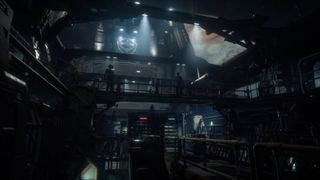
The Grip (GRP) system briefly shown in the new gameplay trailer is one example. Grip works like a gravity gun, letting you pull in or launch enemies as long as you have energy to burn. But like the Stasis of Dead Space, Grip isn't a gun you equip but a baked-in part of your arsenal. It would normally be used by the guards of the Black Iron prison to restrain inmates, which is a running theme for the scavenged arsenal of protagonist Jacob Lee.
"It's much different than in Dead Space," Schofield says, touching on the surface-level similarities between Grip and Stasis. "You can grab an enemy, you can pull them to you, use a gun, use a melee. Or the better thing is to shoot them across the room, either into a hazard or out of the way for crowd control. Because you're gonna want to go at these guys one-on-one."
There were some things that Dead Space introduced like no HUD, and why would I go back to a HUD?
Glen Schofield
Interestingly, melee attacks are more important here than they were in Dead Space. If you were swinging at Necromorphs, you were probably either panicking in close-quarters, out of ammo, or about to die – or all three. But in The Callisto Protocol, Schofield says melee is often "your first go-to" attack, though he notes that there are some enemies – presumably of the explosive or caustic variety – that you won't want to get close to.
Sign up to the GamesRadar+ Newsletter
Weekly digests, tales from the communities you love, and more
Elsewhere, some mechanics and systems were deliberately tweaked to avoid excess overlap with Dead Space, like Jacob's suit. "We decided that was getting too much like Dead Space," Schofield says. "That was one thing. We didn't upgrade the suit, we changed the suit. It's more like this one is for outdoors, this is for the cold, this can take more hits. But you don't upgrade that, you upgrade the skill trees for your weapons. That's the big thing. How do I want to use my weapons and save that stuff? You're probably going to go down one direction, but it allows for replayability when you go down another direction. The weapons have all kinds of upgrades. We spent a lot of time making that work."
Jacob and Isaac

Combat seems more advanced in The Callisto Protocol, but it hasn't gotten any easier. As I tell Schofield, I like to put horror games on a spectrum. At one end you have games like Outlast, where you'll hide in a locker if you so much as hear a rat fart. And at the other end are games like Dead Space and Resident Evil Village, where you're still scared and in danger but also much more active in how you engage with threats. I ask Schofield where he wants The Callisto Protocol to land, and unsurprisingly he reckons it's toward the Dead Space end – it's in his DNA, after all - but also just shy of it, in terms of how powerful you are.
"In Dead Space, he could really ammo up," he says, referring to the equipment of main character Isaac Clarke. "He'd get that one thing where he's shooting the gun around his head, you've got line weapons. I would say it's slightly less so [in The Callisto Protocol]. But if you use the tools you've got and upgrade, you'll be OK. It's gonna be a hard game, and it's gonna be scary in that respect. Some of these enemies can really take you out. We want to keep it scary, but I didn't want it to be like some survival horror where I've got one bullet and nothing else."
Difficulty is an area Striking Distance continues to tweak as the December 2, 2022 release date inches ever closer. Schofield says his team is paying particular attention to how many times an encounter will probably kill a player, and whether that feels right for the scenario. "I'll be like, 'You know what, right here, you can die four times and I'm OK with that.' Other times, 'No, that's too much here, they should be able to get past this pretty well." Schofield adds that he wants players to feel a sense of unpredictability in the scale of challenge – encountering moments where you may need to die once to better learn from the experience, and others where all you can do is grit your teeth and hope for the best. "We do that on purpose," he says.
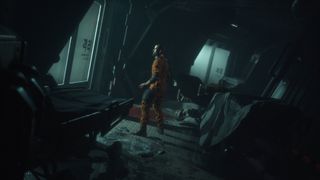
This also feeds back into Jacob's character, which provides yet more evidence that you can't totally take the Dead Space out of The Callisto Protocol. Schofield stresses that, like Isaac, Jacob is far from a John Wick or Leon S. Kennedy badass. He's just a regular everyman, in the wrong place at the worst time, doing anything he can to survive
"He's a guy. He's a pilot. Even the weapons he gets are mostly – like the stun baton, that's something that the guards would use. And even the weapons, they're more heavy duty, but they were guard weapons. He's not a badass. You'll find as you're playing him, he's a dude. He's not real nimble, he's not sliding under doors."
A horror game for a new generation - of hardware and players
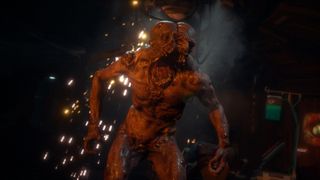
The Callisto Protocol is an extremely Schofield game, and as a work of horror, it also taps into a very specific nightmare. From its first trailer, it was clear that its enemies are mostly humanoid, often the result of Black Iron prisoners and guards put through a truly grisly transformation. Schofield doesn't even try to hide his style here, but what is it about this kind of body horror that draws him in?
"In Dead Space, I had some of the top concept artists in the world working on it," he says, explaining the legwork behind the Necromorphs that ultimately embodied his approach to monsters. "And I'm like, try amoebas, try fish, try insects. We tried everything. But I can step on an insect, I can catch a fish – they didn't feel scary. So I'm like, what scares me in movies? What scares me in real life? A deranged human is one of the scariest things; you just feel that there's more intelligence there than meets the eye. I always come back to something human because, you see a head on something – we've got a long [enemy] that's got a head on it – and that's just freaking creepy. At least, it's creepy to me. There's always that creeped out human that gets me. You see the eyes and they look alive. There's a human in there."
One confusing connection has been the PUBG universe in the works at publisher Krafton. Up until recently, The Callisto Protocol was meant to be part of the PUBG universe, though its place in it was tenuous at best, more of an Easter egg than a narrative pillar. This always struck me as the kind of detail that would've been sprinkled on top to help ground a new studio's first project or give it some visibility, perhaps to help get the game greenlit internally. Schofield doesn't fully deny that, but he says the PUBG universe was never forced on The Callisto Protocol and that Krafton has always believed in his ideas.
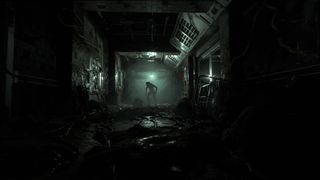
"You're not absolutely wrong," Schofield begins. "Coming into it, when I started in 2019, PUBG was still on the heels of being this giant, giant thing. And they're working on a story, this timeline, and they're like, you think your game could fit on the timeline? And I'm like, it'd be kind of cool. Maybe I need the PUBG thing? I don't know. And it wasn't because I didn't think that we had a good enough reputation. Maybe worldwide that would help springboard it. But the truth is, as we're making it, we're going farther away. Marketing or PR, whatever that gave us, it felt better just to be on its own. We didn't talk about sales, we just talked about what felt right."
"And it was our idea," he reiterates. "So we went back and I just went to [Changhan Kim], who's the CEO, and I just went, 'Hey this would be much better, we feel, if it's not attached anymore. Saying it's attached is disingenuous.' So he was like, 'All right, cut it free.'"
I gotta get back to this. I got another one in me.
Glen Schofield
While the lineage is certainly there, The Callisto Protocol was born from much more than Dead Space. Schofield tips his hat to some of the best horror games and films for inspiration – including Resident Evil and Silent Hill. But that isn't all. In another sense, you could even trace The Callisto Protocol back to Call of Duty: WW2, which gave Schofield – then at Sledgehammer Games, another studio he founded – an opportunity to run wild with Nazi zombies and rekindle his love of survival horror. Not even the biggest shooter in gaming could keep him away forever.
"I enjoyed my Call of Duty time. But if you notice on WW2, I decided to go back to horror with Nazi zombies. And I wanted to go realistic. Different from Treyarch, different from [Infinity Ward]. How can I scare four people at once? After doing that for a couple years, and of course the single-player too, I'm like, man, I gotta get back to this. I got another one in me."
Austin freelanced for the likes of PC Gamer, Eurogamer, IGN, Sports Illustrated, and more while finishing his journalism degree, and he's been with GamesRadar+ since 2019. They've yet to realize that his position as a senior writer is just a cover up for his career-spanning Destiny column, and he's kept the ruse going with a focus on news and the occasional feature, all while playing as many roguelikes as possible.
Most Popular




